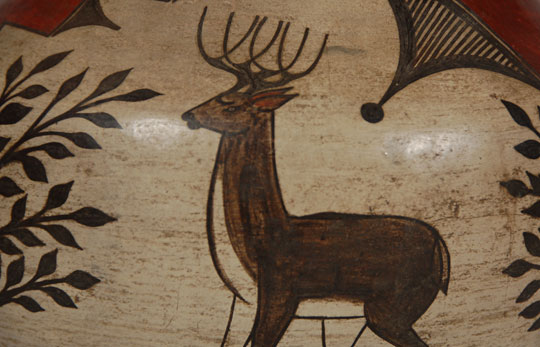Historic Zia Pueblo Polychrome Olla with Deer Design [SOLD]
+ Add to my watchlist Forward to Friend
- Category: Historic
- Origin: Zia Pueblo, Tsi-ya
- Medium: clay, pigment
- Size: 9-1/4” tall x 10” diameter
- Item # C3265B SOLD

Turn-of-the-century pottery from Zia Pueblo displays a deep red color to the slip as well as very deep brown mineral-based pigment used in the designs. These deep wonderful colors disappeared in post-1900 pottery and the red became more tomato soup color and the brown a weaker tint. According to Harlow and Lanmon, "There are discernible changes in the character and physical characteristics of the red and black pigments that further assist us in dating individual vessels." The black pigment was generally browner in coloration until 1850 and then tended to become darker after that. By 1900, the black appears to be dark strong brown. The red pigments varied from deep red to orange-red to brick-red but by 1900 the red tended to be dark in coloration.
It is based on the beautiful dark red and strong brown pigments in this jar that we have selected a date of 1890 to 1910 as the most probable period in which it was made. It was during this period also that some pottery began to be associated with particular makers by name. A couple of potters of this period who made jars of the high quality of this one are Isabel Medina Toribio and Trinidad Gachupin Medina. We are not making an attribution to either of these potters but mention them as possibly responsible.
The brown pigment in the floral elements on this jar is very thick and rich in color. The brown pigment on the deer was applied in lighter tint. The red band on the lower underbody that separates the cream slip from the polished red underbody is another indication for dating pottery of the circa 1900 period. Before 1910, the red band is distinguishable from the polished underbody but that distinction begins to disappear after 1910. The red band on this jar is quite distinguishable, an indication that the jar pre-dates 1910. There is a deep concave bottom to the jar.
Condition: overall the jar is in very good condition for its age. There are indications that the jar was used for its intended purpose. There are a couple cracks that have been stabilized and there is slip loss near the rim resulting from overflow of water while in use.
Provenance: from the collection of a gentleman in Colorado
Recommended Reading: The Pottery of Zia Pueblo by Francis H. Harlow and Dwight P. Lanmon

- Category: Historic
- Origin: Zia Pueblo, Tsi-ya
- Medium: clay, pigment
- Size: 9-1/4” tall x 10” diameter
- Item # C3265B SOLD
Adobe Gallery Recommended Reading
Adobe Gallery Recommended Items
If you are interested in this item, we would also like to recommend these other related items:



